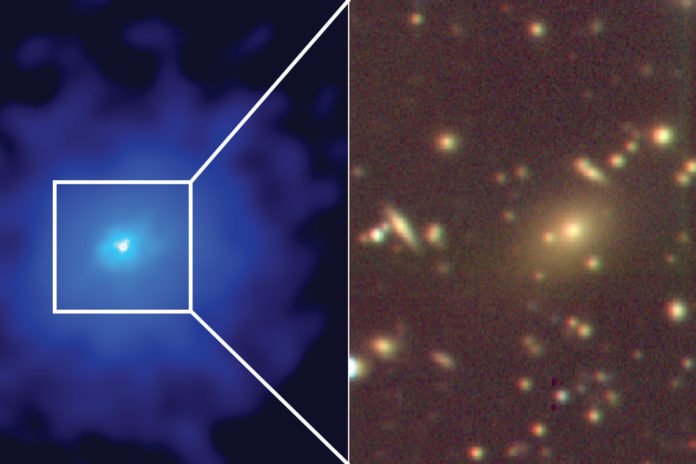Scientists at the MIT have captured a sprawling new galaxy cluster hiding in plain sight. They found that the cluster which is mere 2.4 billion light-years away from Earth, holds a number of galaxies which, all told, is about as massive as 690 trillion suns. Moreover, scientists estimated that the cluster is surrounded by an extremely active supermassive black hole or quasar.
Scientists dubbed this quasar as PKS1353-341. It is bright enough that it has obscured hundreds of galaxies clustered around it.
During the study, scientists also calculated that the quasar at the center of the cluster is 46 billion times brighter than the sun.
Its outrageous glow is likely the consequence of a transitory encouraging free for all: As a tremendous circle of material swirls around the quasar, enormous pieces of matter from the plate are falling in and sustaining it, making the dark gap transmit gigantic measures of energy out as light.
Study author Michael McDonald said, “This might be a short-lived phase that clusters go through, where the central black hole has a quick meal, gets bright, and then fades away again. This could be a blip that we just happened to see. In a million years, this might look like a diffuse fuzzball.”
In 2012, McDonald and others discovered the Phoenix cluster, one of the most massive and luminous galaxy clusters in the universe. The mystery to McDonald was why this cluster, which was so intensely bright and in a region of the sky that is easily observable, hadn’t been found before.
McDonald said, “We started asking ourselves why we had not found it earlier, because it’s very extreme in its properties and very bright. It’s because we had preconceived notions of what a cluster should look like. And this didn’t conform to that, so we missed it.”
“For the most part, astronomers have assumed that galaxy clusters look “fluffy,” giving off a very diffuse signal in the X-ray band, unlike brighter, point-like sources, which have been interpreted as extremely active quasars or black holes.”
“The images are either all points or fluffs, and the fluffs are these giant million-light-year balls of hot gas that we call clusters, and the points are black holes that are accreting gas and glowing as this gas spirals in. This idea that you could have a rapidly accreting black hole at the center of a cluster — we didn’t think that was something that happened in nature.”
In any case, the Phoenix disclosure demonstrated that galaxy clusters could for sure host tremendously dynamic black holes, inciting McDonald to ponder: Could there be other adjacent universe groups that were basically misidentified?
To answer that inquiry, the analysts set up an overview named CHiPS, for Clusters Hiding in Plain Sight, which is intended to reexamine X-beam pictures taken previously.
For each point source that was beforehand recognized, the analysts noticed their directions and afterward considered them all the more straightforwardly utilizing the Magellan Telescope, a ground-breaking optical telescope that sits in the mountains of Chile. In the event that they watched a higher-than-anticipated number of systems encompassing the point source (a sign that the gas may originate from a group of universes), the analysts took a gander at the source once more, utilizing NASA’s space-based Chandra X-Ray Observatory, to recognize a broadened, diffuse source around the principle point source.
McDonald said, “Some 90 percent of these sources turned out to not be clusters. But the funny thing is, the small number of things we are finding is sort of rule-breakers.”
“The brightness of the black hole might be related to how much it’s eating. This is thousands of times brighter than a typical black hole at the center of a cluster, so it’s very extreme in its feeding. We have no idea how long this has been going on or will continue to go on. Finding more of these things will help us understand, is this an important process, or just a weird thing that there’s only one of in the universe.”
McDonald and his colleagues believe the discovery of this hidden cluster shows there may be other similar galaxy clusters hiding behind extremely bright objects that astronomers have miscatalogued as single light sources. The researchers are now looking for more hidden galaxy clusters, which could be important clues to estimating how much matter there is in the universe and how fast the universe is expanding.
The paper’s co-authors include lead author and MIT graduate student Taweewat Somboonpanyakul, Henry Lin of Princeton University, Brian Stalder of the Large Synoptic Survey Telescope, and Antony Stark of the Harvard-Smithsonian Center for Astrophysics.
Scientists have published their paper in the Astrophysical Journal.
